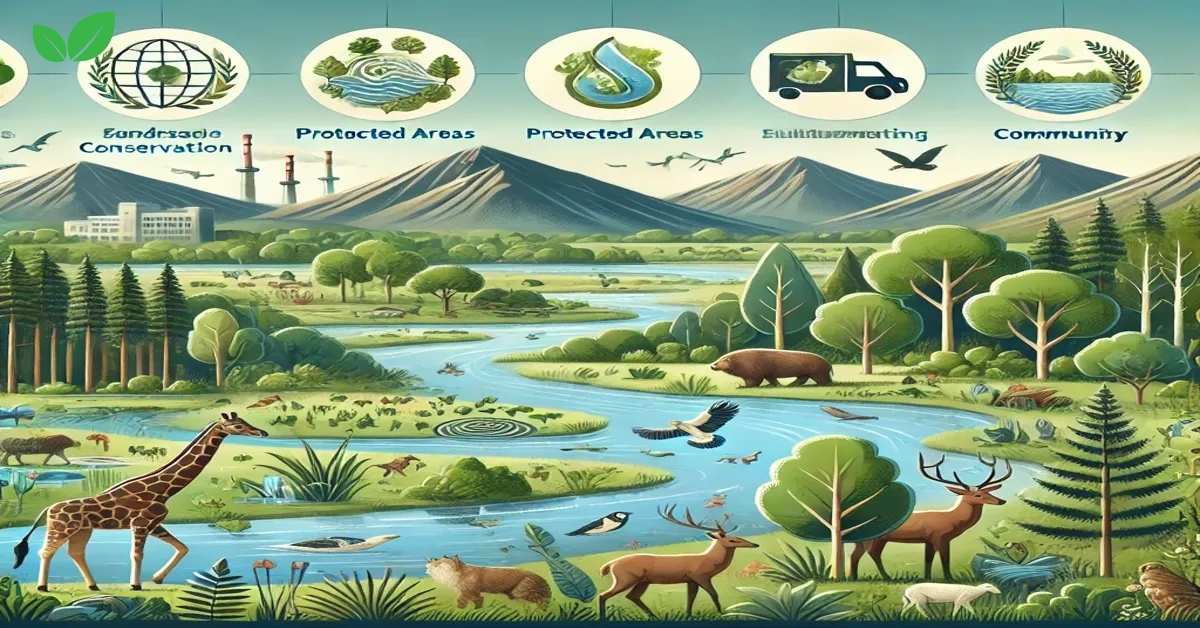Landscape Conservation Cooperatives (LCCs) represent a collaborative approach to conserving ecosystems across large geographical areas. These cooperatives are designed to bring together stakeholders such as federal, state, and local governments, tribal nations, conservation organizations, researchers, and private landowners to address the complex challenges of preserving biodiversity, managing natural resources, and adapting to climate change. By focusing on landscape-scale conservation, LCCs work to ensure that ecosystems remain resilient, species can thrive, and communities can continue to benefit from the natural resources that sustain them. This article delves into the environmental niche of Landscape Conservation Cooperatives, covering their origins, goals, roles in conservation, challenges, and success stories.
1. Understanding Landscape Conservation Cooperatives
Landscape Conservation Cooperatives (LCCs) emerged as a response to the recognition that conservation challenges often extend beyond the boundaries of individual states, parks, or protected areas. They are designed to address these challenges by working across jurisdictional lines, bringing diverse stakeholders together to create and implement strategies that sustain landscapes at a regional scale.

1.1. Origins of the Landscape Conservation Cooperative Model
- Establishment and Framework: The LCC initiative was launched in 2009 by the U.S. Department of the Interior as part of a broader effort to address climate change and habitat degradation across North America. It was created to complement existing conservation programs like the National Wildlife Refuge System by focusing on a landscape-scale approach.
- Foundational Principles: Landscape Conservation Cooperatives are built on the principles of collaboration, data-sharing, and adaptive management. Their mission is to integrate the expertise of different sectors and ensure that conservation efforts are data-driven and responsive to changing environmental conditions.
- Geographical Scope: LCCs are organized across 22 regions in the United States, Canada, Mexico, and parts of the Caribbean and Pacific Islands. Each LCC focuses on a specific landscape or ecosystem, such as coastal regions, grasslands, deserts, or watersheds, where ecological and cultural resources are interconnected.
1.2. Key Goals and Objectives
- Biodiversity Conservation: A primary goal of Landscape Conservation Cooperatives is to conserve biodiversity by protecting habitats, restoring ecosystems, and supporting species recovery efforts. They work to ensure that species have the habitats they need to thrive, even as those habitats change due to climate shifts or human activities.
- Climate Adaptation: LCCs are focused on helping ecosystems and communities adapt to the impacts of climate change. This includes addressing issues like sea-level rise, increased frequency of extreme weather events, and shifts in species distributions.
- Sustainable Resource Management: LCCs seek to promote sustainable management of natural resources such as water, forests, and fisheries. They work with stakeholders to develop practices that balance conservation needs with economic and recreational activities.
- Cultural Resource Protection: Recognizing the importance of cultural heritage, Landscape Conservation Cooperatives also work to protect landscapes that hold significant cultural value for Indigenous communities and local populations. This involves collaborating with tribal nations to integrate traditional ecological knowledge into conservation strategies.
2. The Role of Landscape Conservation Cooperatives in Ecosystem Management
Landscape Conservation Cooperatives play a critical role in the management and protection of ecosystems by coordinating efforts across vast and diverse landscapes. Their work involves creating partnerships, developing scientific tools, and implementing strategies that address both current and future conservation challenges.
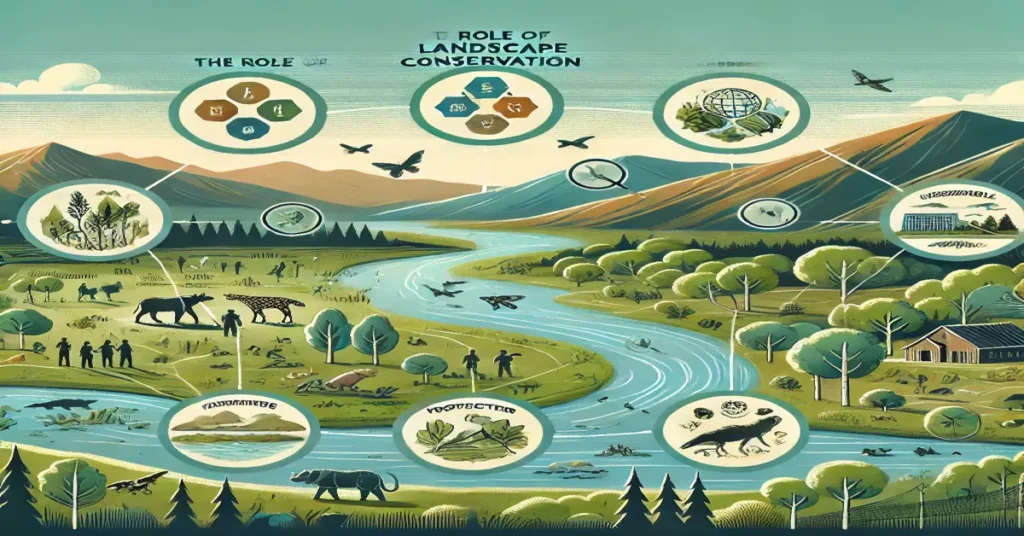
2.1. Collaborative Approach to Conservation
LCCs bring together a diverse range of stakeholders, allowing for a more holistic approach to conservation:
- Building Partnerships: Landscape Conservation Cooperatives connect federal agencies, state and local governments, non-governmental organizations (NGOs), academic researchers, tribal governments, and private landowners. These partnerships enable the sharing of resources, expertise, and data, creating a unified front in addressing conservation challenges.
- Community Engagement: Local communities play a crucial role in the success of LCC initiatives. By engaging communities, LCCs ensure that conservation efforts are aligned with local needs and values, leading to better outcomes and greater support for long-term sustainability.
- Cross-Boundary Management: Many ecological processes, such as migration, water flow, and fire regimes, occur across political boundaries. LCCs work to manage these processes at the landscape scale, ensuring that actions taken in one area do not have unintended negative impacts on another.
2.2. Scientific Research and Data Sharing
Science is at the heart of the LCC approach, providing the basis for evidence-based decision-making:
- Development of Decision-Support Tools: LCCs invest in the creation of decision-support tools that help stakeholders assess the impacts of climate change and other stressors on natural systems. These tools include habitat models, climate vulnerability assessments, and scenario planning frameworks.
- Data Integration and Monitoring: LCCs collect, integrate, and share data on a wide range of ecological indicators, from species populations to water quality and land use patterns. This data is critical for monitoring the effectiveness of conservation actions and adjusting strategies as needed.
- Adaptive Management: The use of adaptive management is a cornerstone of LCC efforts. This approach involves implementing conservation actions, monitoring their outcomes, and using the results to refine and improve strategies over time. This flexibility allows LCCs to respond to emerging challenges and opportunities.
2.3. Landscape-Level Restoration and Connectivity
Landscape Conservation Cooperatives emphasize the importance of restoring ecological connectivity and resilience across landscapes:
- Habitat Restoration: LCCs support projects aimed at restoring degraded habitats, such as reforestation of riparian zones, wetland rehabilitation, and prairie restoration. These efforts help improve ecosystem functions, provide habitat for wildlife, and enhance ecosystem services like water filtration.
- Creating Wildlife Corridors: In many regions, habitat fragmentation poses a major threat to wildlife populations. LCCs work to establish wildlife corridors that connect isolated habitats, allowing species to move freely in search of food, mates, and suitable conditions as climate conditions change.
- Building Climate Resilience: By restoring natural systems and enhancing their connectivity, Landscape Conservation Cooperatives help build resilience against climate-related stressors such as drought, fire, and flooding. Resilient ecosystems are better able to adapt to changing conditions and continue providing benefits to people and wildlife.
3. Ecological and Social Benefits of Landscape Conservation Cooperatives
The work of Landscape Conservation Cooperatives extends beyond the protection of biodiversity. Their efforts result in tangible ecological and social benefits, from maintaining ecosystem services to fostering economic opportunities through sustainable practices.
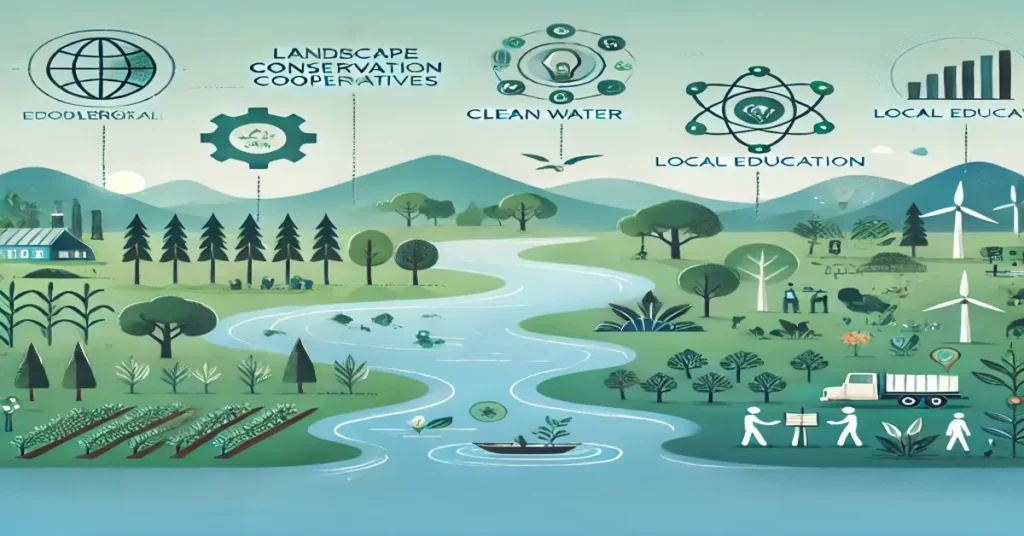
3.1. Conservation of Biodiversity
- Protecting Endangered Species: LCCs play a key role in the conservation of species that are threatened or endangered. By focusing on habitat preservation and restoration at a landscape scale, Landscape Conservation Cooperatives create conditions that allow vulnerable species to recover and maintain viable populations.
- Enhancing Genetic Diversity: By connecting isolated populations through habitat corridors, Landscape Conservation Cooperatives help maintain genetic diversity within species. This is crucial for the long-term survival of species, as it increases their ability to adapt to changing environmental conditions.
- Preserving Ecosystem Function: The holistic approach of LCCs helps maintain the ecological processes that sustain biodiversity. This includes nutrient cycling, pollination, and the regulation of natural disturbances like fires and floods, which are essential for healthy ecosystems.
3.2. Ecosystem Services and Human Well-Being
- Water Quality and Supply: Many LCC projects focus on protecting watersheds, which are crucial for maintaining clean water supplies for both people and wildlife. Restoring wetlands and riparian zones can improve water quality by filtering pollutants and reducing sedimentation.
- Carbon Sequestration: By promoting reforestation and the protection of intact forests, Landscape Conservation Cooperatives contribute to carbon sequestration, helping to mitigate the impacts of climate change. Healthy forests and grasslands store carbon in their biomass and soils, playing a vital role in regulating the Earth’s carbon cycle.
- Recreation and Tourism: The preservation of landscapes through LCCs often leads to the enhancement of natural areas that support recreational activities such as hiking, bird-watching, fishing, and camping. This not only supports physical and mental well-being but also boosts local economies through eco-tourism.
3.3. Economic and Cultural Benefits
- Sustainable Agriculture and Forestry: LCCs work with agricultural and forestry stakeholders to promote practices that are both economically viable and ecologically sustainable. This includes sustainable grazing, water-efficient farming techniques, and forest management practices that reduce fire risk while preserving biodiversity.
- Preserving Cultural Heritage: Many Landscape Conservation Cooperatives work closely with Indigenous communities to protect cultural resources that are tied to the landscape, such as sacred sites, traditional hunting grounds, and plant species used in traditional medicine. These collaborations ensure that cultural heritage is respected and preserved for future generations.
- Job Creation and Capacity Building: The implementation of conservation projects through LCCs often requires local labor and expertise, creating job opportunities in rural and underserved areas. This capacity-building helps foster local stewardship and long-term commitment to conservation goals.
4. Challenges and Barriers to the Success of Landscape Conservation Cooperatives
While Landscape Conservation Cooperatives have achieved significant successes, they also face challenges that can hinder their effectiveness. Understanding these challenges is crucial for improving future efforts and ensuring the sustainability of conservation initiatives.
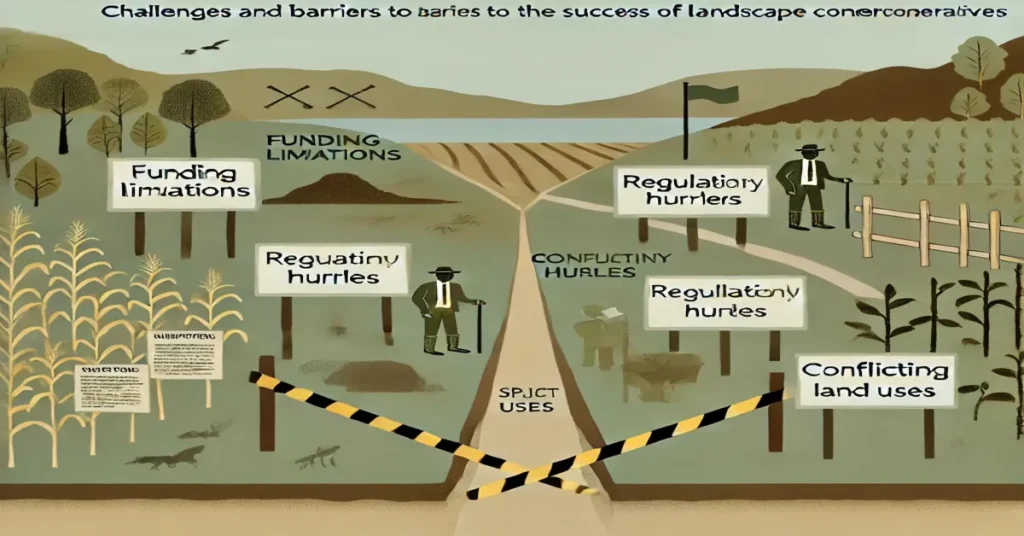
4.1. Funding and Resource Constraints
- Limited and Inconsistent Funding: One of the most significant challenges facing Landscape Conservation Cooperatives is the inconsistency of funding. Many LCC projects rely on federal and state funding, which can fluctuate based on political priorities and budgetary constraints. This can make long-term planning difficult and hinder the continuity of conservation efforts.
- Competition for Resources: LCCs often have to compete with other conservation programs for limited resources. This can lead to challenges in securing the financial and technical support needed for large-scale projects, especially in regions where conservation is not seen as a priority.
4.2. Political and Administrative Challenges
- Policy Changes and Shifts: The priorities and strategies of LCCs can be affected by changes in government policy and leadership. Shifts in administration may alter the level of support for conservation initiatives, potentially leading to a loss of momentum for ongoing projects.
- Navigating Jurisdictional Boundaries: Working across state and national borders can pose administrative challenges, as different regions may have varying regulations and conservation priorities. LCCs must navigate these complexities to coordinate actions and maintain a cohesive strategy.
4.3. Balancing Diverse Stakeholder Interests
- Conflicting Interests: Landscape Conservation Cooperatives often bring together stakeholders with different interests, such as conservationists, ranchers, developers, and Indigenous groups. Balancing these interests while ensuring that conservation goals are met can be a delicate and challenging process.
- Building Trust and Consensus: Effective collaboration requires trust among partners, which can take time to build. Landscape Conservation Cooperatives must invest in relationship-building and communication to ensure that all stakeholders feel heard and respected in the decision-making process.
5. Success Stories and Case Studies
Despite the challenges, many Landscape Conservation Cooperatives have demonstrated the power of collaboration and landscape-scale conservation. These success stories highlight the potential of the LCC model to create lasting positive impacts on both ecosystems and communities.
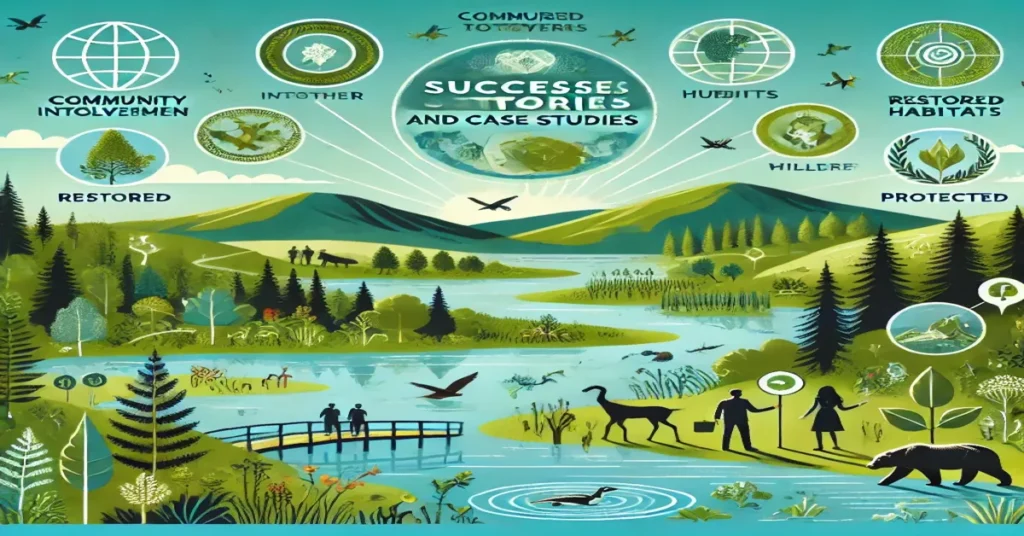
5.1. The Appalachian LCC: Protecting Forest Ecosystems
- Focus on Forest Connectivity: The Appalachian LCC has been instrumental in protecting the vast forested landscapes of the Appalachian Mountains. By working with land trusts, state agencies, and private landowners, the LCC has helped establish wildlife corridors that connect isolated forest patches, allowing species like black bears, bobcats, and migratory birds to move freely.
- Climate Adaptation Research: The Appalachian LCC has also developed climate adaptation strategies to help forests cope with the impacts of climate change. This includes identifying priority areas for conservation based on their resilience to climate shifts, ensuring that these forests can continue to provide habitat and ecosystem services in the future.
5.2. The Desert LCC: Water Management in Arid Regions
- Water Conservation Efforts: The Desert LCC, spanning the arid regions of the southwestern United States and northern Mexico, focuses on managing scarce water resources in a changing climate. Projects include the restoration of riparian areas and the development of sustainable water use practices for agricultural and urban communities.
- Collaborating with Indigenous Tribes: The Desert LCC has worked closely with Indigenous tribes to integrate traditional knowledge into water management strategies. These partnerships have led to culturally sensitive conservation practices that respect Indigenous rights and improve water availability for both people and wildlife.
5.3. The Great Plains LCC: Grassland Restoration
- Restoring Prairie Ecosystems: The Great Plains LCC has focused on restoring grasslands that have been degraded by agricultural expansion and invasive species. Through partnerships with ranchers and conservation groups, the LCC has implemented grazing management practices that improve soil health, increase carbon sequestration, and support native wildlife such as prairie chickens and bison.
- Resilience to Extreme Weather: The Great Plains region is prone to extreme weather events, including droughts and floods. The LCC’s efforts to restore natural floodplains and wetlands have helped reduce the impact of these events, protecting both human communities and the natural environment.
Conclusion
Landscape Conservation Cooperatives represent a forward-thinking approach to conservation, one that recognizes the interconnectedness of ecosystems, communities, and economies. By focusing on collaboration, data-driven decision-making, and adaptive management, Landscape Conservation Cooperatives work to ensure that landscapes remain resilient in the face of climate change and other environmental challenges. Their efforts help protect biodiversity, maintain ecosystem services, and create sustainable opportunities for communities across North America and beyond.
The success of Landscape Conservation Cooperatives depends on continued investment in partnerships, science, and community engagement. By addressing the challenges of funding, political shifts, and stakeholder coordination, Landscape Conservation Cooperatives can continue to build on their achievements and create a brighter future for both people and nature. As we look to the future, the work of LCCs serves as a powerful reminder that the conservation of our natural world is a shared responsibility—one that requires cooperation across boundaries, commitment to long-term goals, and a deep respect for the landscapes that sustain life on Earth. Through their efforts, Landscape Conservation Cooperatives are helping to shape a world where ecosystems thrive, communities flourish, and nature’s resilience endures.
Read More: Environment One Pager: A Comprehensive Overview of Global Environmental Challenges and Solutions

